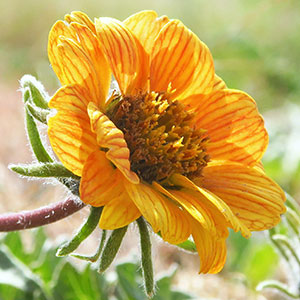Balsamorhiza careyana
Balsamorhiza rosea
Carey's balsamroot
rosy balsamroot
blades green, rounded-deltate or deltate to triangular-deltate, 15–25 × 6–15 cm, bases cordate or hastate to truncate, margins usually entire, sometimes crenate (to dentate near bases), apices acute to attenuate, faces finely hispidulous to hirtellous (gland-dotted as well).
blades gray-green, oblong to lance-ovate, 3–10(–20) × 2–5 cm (rarely pinnately lobed), bases weakly cordate or truncate, margins crenate to serrate, apices rounded to acute, faces finely strigose to moderately scabrous (usually gland-dotted as well).
hemispheric to turbinate or campanulate, 12–20 mm diam.
hemispheric, 18–20 mm diam.
20–30(–40) mm (cypselae strigose or glabrous).
(becoming brick-red, often drying to pink or rose, and chartaceous) (8–)15(–25) mm (hispidulous abaxially; cypselae strigose).
oblong to lanceolate or linear, 15–25 mm, usually surpassing inner, apices acute to attenuate.
deltate or ovate to lanceolate, 8–12 mm, not surpassing inner.
usually (2–)3+, sometimes borne singly.
usually borne singly.
= 38.
= 38.
Balsamorhiza careyana
Balsamorhiza rosea
Hybrids involving Balsamorhiza careyana and B. deltoidea occur near the Columbia River Gorge; intermediates are found to the east and south. In northern Oregon, plants in some populations have glabrous cypselae and some populations are mixed. The hairiness may come from B. rosea; B. rosea and B. careyana may hybridize profusely, producing mostly plants with the stature of B. careyana and with the relatively short, brick-red ray corollas of B. rosea. Hybridization also occurs, occasionally, between B. careyana and B. sagittata; B. careyana also hybridizes with any species of sect. Balsamorhiza with which it comes in contact. Plants called Balsamorhiza careyana var. intermedia usually have crenate leaf margins and glabrous cypselae.
(Discussion copyrighted by Flora of North America; reprinted with permission.)
In a hybrid swarm involving Balsamorhiza rosea and B. careyana, B. rosea remains relatively uncontaminated; the dominance among the hybrids appears to lie with B. careyana. A record of a hybrid between B. rosea and B. careyana from the Spokane area is doubtful.
(Discussion copyrighted by Flora of North America; reprinted with permission.)


